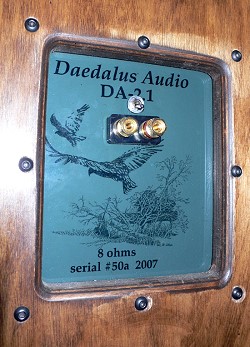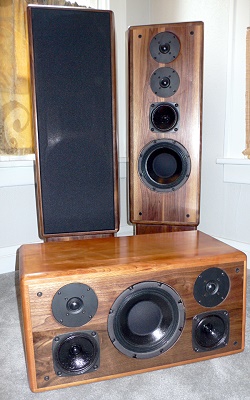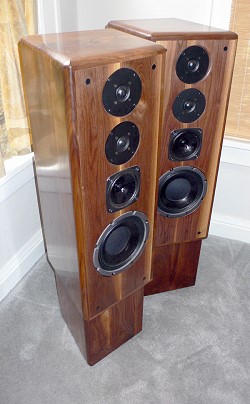Introduction
When Lou Hinkley sent me a pair of his Daedalus DA-1 speakers and matching center channel back in 2005, I considered them to be beautifully made with wonderful sound. Then, when he brought me his updated version, the DA-2.1, I realized I had already run out of adjectives to describe them.
Like the DA-1s, the DA-2.1s are made from solid hardwood, not MDF or HDF. So it’s not a question of which finish (veneer) would you like? but rather, which hardwood would you like? Daedalus speakers can be made from Cherry, Ebonized Walnut, Maple, Oak, or Walnut harvested with sustainable forest practices.
The enclosures are 30″ high, and you add 11.5†to that if you get the matching stands. This brings the two Eton tweeters on each speaker up to ear height, which is where you want them. The other drivers are a Daedalus designed 8†woofer and modified 5†Fostex midrange. Efficiency is a whopping 95.5 dB, and impedance is 6 ohms nominal, so they will be relatively easy to drive. Inside the enclosure, 13 ply birch plywood backs the front panel, bringing the entire baffle depth to 1.5â€. Internal wiring is with braided audiophile grade silver and copper wire to and from separate crossover boards for each driver. The wiring connection is up high on the back, not near the base as on most speakers. Near the binding posts is a switch that adds or subtracts from the high frequency output. I left this switch in Neutral 99% of the time. At the base of the cabinet at the rear are two ports for the woofer. The midrange has its own sealed cabinet within the 2.1’s.
Specifications
- Design: Three-way, Sealed Enclosure
- Drivers: Two 1″ Dome Tweeters, One (Two in Center Channel Speaker) 5″ Midrange, One 8″ Woofer
- MFR: 38 Hz – 22 kHz, ± 2 dB
- Nominal Impedance: 6 Ohms
- Power Handling: 200 Watts RMS (250 Watts for Center Channel Speaker)
- Tweeter Adjustment Switch for ± 2dB
- Dimensions: 30″ H x 11″ W x 13″ D (12″ x 24″ x 13″ for Center Channel Speaker)
- Weight: 56 Pounds/Each (36 Pounds for Center Channel Speaker)
- MSRP: $4,550/Pair USA ($2,450 for Center Channel Speaker)
- Daedalus Music
Aside from the extraordinary woods and finishes on Daedalus speakers, the most striking feature is the shape. In order to prevent internal reflections, the front baffle angles back to the inside, towards the listener. Or, put more simply, if the speakers were placed flush against the back wall, it would still be as if they were towed in as far as the drivers were concerned.
This shape may take some getting used to. When you look at these speakers, it can sometimes feel like you’re are looking at a Savador Dali painting because what you are expecting to be a right angled box is not. The effect is not as dramatic as with the DA-1s which have an additional odd angle, as the front baffle is sloped back top to bottom.
But, I’ve come to appreciate the shape of the DA 2.1s, and the overall effect in my living room is that the speakers don’t seem to take up much space, but also appear pleasingly large. The natural finish on the hardwoods tends towards a classic look rather than sleek and modern, but the shape prevents any thoughts that the speakers appearance is boxy. The angles are elegant. The fit and finish are just gorgeous, especially to fans of woodworking.
Â
Â
The Center 2.1 has the same woofer and two tweeters but adds a second midrange. These are not arranged in a D’Appolito array as you might expect, rather the center woofer has a vertically arranged mid and tweeter to both the left and right. The internal-reflection-damping shape is achieved in the center simply by angling the front baffle back. This speaker is meant to be stand mounted from the floor, under the TV, or inverted and hung from the ceiling with the proper hardware. It’s a little too large in my opinion to simply be placed on top of a large rear projection TV. Rear projectors are shrinking or disappearing altogether these days anyway.
Grilles attach via magnets, but I left them off for the entire review period because I think speakers look and sound better without them.
As I wrote in my review of the DA-1s, building speakers and especially their cabinets is a labor of love for Daedalus’ founder Lou Hinkley. A guitar player himself, he started his company as ‘Daedalus Cabinets’ which makes enclosures for guitar amplifiers. I mention this because I’ve got a new theory about musicians and recorded music: Musicians naturally have a good ear for music recordings but often have cheap stereos.
Undoubtedly this is due in part to what they can afford. But I’ve encountered enough musicians who scoff at the notion of expensive home hifi to know that there is something more going on. Here it is: Musicians ears are trained by listening to live music. When they listen to the studio monitor or whatever passes for a home stereo at their house, they and their ears know that they are not getting the live music experience, but it recalls for them the live music experience that they just had earlier that day. I’ve noticed the same effect in myself; my ears are trained by listening to vinyl such that I can enjoy CDs more, without getting caught up in their shortcomings. Anyway, Mr. Hinkley is one of those musicians who does appreciate home high fidelity playback, and he uses his memory of what live music sounds like to voice his speakers.

Â
Â
Â
Â
Â
Â
Â
Â
Â
Â
Â
And, the enclosures for these speakers are extraordinary. The quick and dirty check that anyone can do for cabinet resonances is to knock on them. If you knock on cheap speakers, you hear the box, the resonance of the cabinet. Knock on the side of these Daedalus DA-2.1s and they sound solid, because they are solid. No resonance of any kind is evident. Hit them hard and you will hurt your knuckles.
Speaker Comparisons
Jumping ahead a little here, after some time with the Daedalus’ I told my local hifi shop (Stereotypes Audio in Portland, Oregon) that I was considering buying the 2.1’s. This hasn’t been finalized yet, more on that later. When they heard about this, they wanted me to try some Focal Electra 1027 Be’s. In short, the Focal 1027 Be’s are fussy about setup, but once that is done they are very enjoyable speakers, with excellent detail in the midrange, but somewhat complex bass. Even with the best setup I could manage in my room, there still seemed to be a narrow range in the mid-bass that was muddled. The tweeter on the other hand was a different story.
Â
Â
Tweeter Wars
A couple of years ago, I reviewed some nice sounding kit speakers from Raw Acoustics that used a ribbon tweeter. In some ways, the Focal tweeter outperformed all other tweeters I heard, I felt like I could hear into the sound of high hats or female voices like I hadn’t before, though there was some emphasis on the high end overall. When I got the DA-2.1’s and then the Focal’s I spent some time swapping between them and with my old school Gold Sound kit #9’s. With the twin tweeters on the DA’s and the beryllium tweeter on the Focal’s, the old Gold Sounds were left in the dust. They just had a dark sound to them by comparison. I hadn’t really noticed this before the tweeter parade started in my house, so to some extent it is something that ears adjust to I think.
Between the Focals and DAs it’s a tougher choice. The Focal’s were picky about setup in my room, but once adjusted, they were terrific speakers, and the imaging was the best of the three. My room is not set up for good imaging, so I’m always surprised when this happens. The one thing the beryllium tweeters did better than any other tweeter I’ve heard is that hollow sound that high hat cymbals make when they are being open and closed via the foot petal. There is a splashy sound to that like any cymbal, but there is also the hollow sound created by the space between them. It was somewhere on disc 1 of the 2006 Tortoise box set A Lazarus Taxon, and when I listened to it, I realized I’d never heard a speaker do that sound as well. It may be because the tweeter has a peak in its frequency response in just the right spot or it may be their shape and stiffness mean that its better suited for this.
Overall though, I think the DA1s have the best solution. By doubling up the tweeters, the listener gets a significant step towards the sound of a ribbon tweeter without peakiness or glare and without the hassle of directionality and beaming. In fact, by pointing the two tweeters in slightly different directions, the DAs create a remarkably even sound throughout the room and adjacent rooms.
I write these articles in a finished attic above the room with my main stereo in it. I can be all the way up here, hearing the Daedalus’ though the staircase and they sounds great.
Imaging is likely sacrificed by this tweeter arrangement though. I can’t say for sure because, as I said, my listening room is not set up well for this, there’s too much distance and stuff between the speakers.
The tweeter switch on the back of the 2.1s did not make the Daedalus’ sound like the Focals in the Boost position or as subdued as my Gold Sounds when in the Attenuate position. It didn’t go that far. I did find it useful once or twice with some CDs that I thought had too much edginess or were dark. This switch could also be useful to balance out speaker cable differences though I found the 2.1s to be rather immune to cable choice and I had some remarkably expensive and remarkably cheap cables during this review period. I’m still experimenting with cables, and I am sad to report that yes there is a difference. Sad because I think the prices charged for some of these cables are not reasonable.
The Sound
So how do the Daedalus 2.1s sound overall? The twin cloth dome tweeters bring you all the highs in the most unobtrusive way. There are no discernable peaks, but everything is there. The speaker seems to present no significant load to my Simaudio W6 amps. Transients come and go with ease. This makes the rhythm and pace spot on. It’s a feeling of lightness or effortlessness. Neither amps nor ears are burdened with complexities. In doing all of this speaker swapping, I relied heavily on “Teardrop” by Massive Attack. Massive Attack is famous for working with all the best female vocalists, and in this case it’s the incomparable Elizabeth Frasier of the Cocteau Twins. When I hear this song on good hi-fi, I swoon, and with the Daedalus, I swooned. I could hear details in the vocal presentation that weren’t there with the Focal’s or Gold Sounds. Details such as breathing and those little growly bits in the back of the throat. You want to hear those, trust me. This track has a rim shot on a snare drum throughout. Each of the speakers I tried had a different resolution of this. It’s hard to say which was best, they were just different, each sounded authentic. On this track and with some intense rock music such as that by Sonic Youth, the Daedalus never merged instruments together. It was always easy to pick out and enjoy each instrument. This is the difference with good hi-fi that you can point out to non-believers.
Another Massive Attack song, “Protection” has become my standard for bass analysis. The 15†JBL woofers on my old Gold Sounds won this one hands down. When they are not exciting room modes, the bass from these reveals textures and nuance in heavy bass lines that smaller speakers will just never give you. The Daedalus 2.1s come remarkably close though. Most of detail is there, just not in your face like with my oversize JBLs. I had to tune into it a little to notice it. This may actually be more in line with the mix that the artists intended, hard to say with electronica. Overall though, with my heavy rock and electronica listening, I could do with just a little more bass. Lou Hinkley offered that the 2.1s do sound best with a subwoofer added. I did not get to this, as my back was not approving of the idea of lugging my subwoofer up to my main stereo room.
I’ve mentioned in previous reviews how I think you can deduce the type of music that some hi-fi manufactures listen to by what their equipment does best on. These speakers were terrific for everything I played on them, but voices and guitars were the most striking. With guitars, the string overtones, the plucking, the overtones from the body of the guitar, I heard these more accurately than with any other speaker I’ve auditioned. The Focals, when properly set up, would have all those same parts present but in different degrees, that, in the end, sounded less realistic.
In the Home Theater
IÂ didn’t want to move my subwoofer upstairs, nor did I want to move the 2.1s downstairs to my home theater room. During this review period I developed my semi-annual back problem. I was able to convince Lou Hinkley to stop by and move the 2.1s downstairs for me. My home theater room is really too small for these speakers and even for the center channel. Still, they represented a significant improvement over my reference Aperions which retail for about 1/10th as much.
The Daedalus center is a full range speaker compared to my much smaller Aperion. Voices, music, whatever were more natural and easier to listen to. The main thing the Daedalus revealed to me though was the difference between my amps. If the Daedalus’ were getting the best out of my Simaudio setup upstairs, they were revealing the shortcomings, relatively speaking, of my old Outlaw 770 in my home theater room. It sounded good, yes, but I knew the speakers could deliver more, and it just wasn’t there in that setup. Of course, this should be expected given the price difference. Match your components carefully and try them out at home if you can.
Conclusions
The Daedalus 2.1s seem to transcend the notion of fatigue, moving to the other side of the scale: listener rejuvenation? Call it what you will, I can’t seem to stop listening. My Tivo is full, and my Netflix is backed up because music has jumped to the top of my priorities. Good thing because I’ve got lots of records. Music server? What’s that? I’d recommend these speakers in a heartbeat. I may well purchase them, I’m going to give a re-listen to the Daedalus 1.1’s which have an extra woofer added, they cost a bit more too. Stay tuned to find out which I choose.




